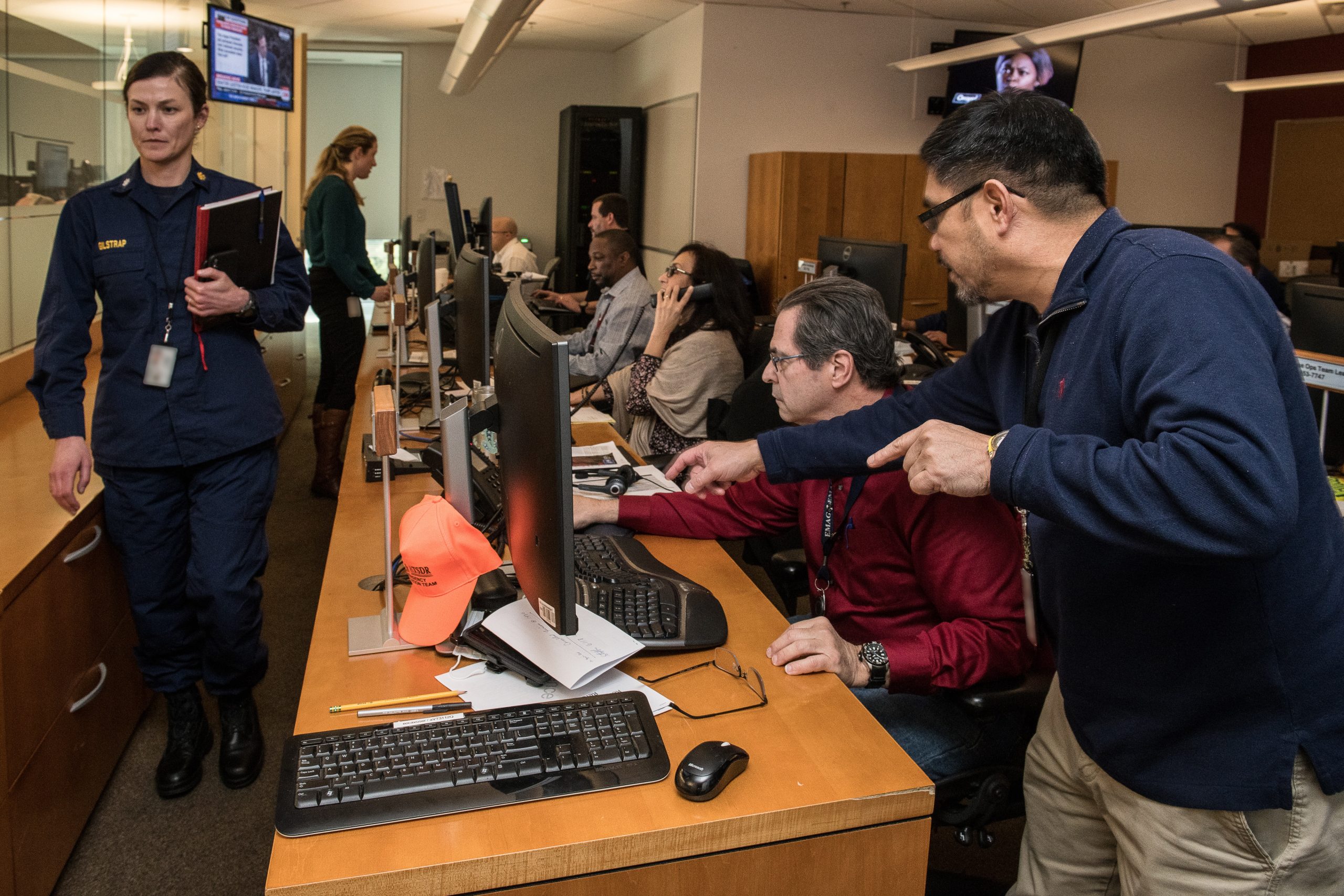149 Chapter Two – Lesson Six
Chapter Essential Questions
- What are the unique challenges faced by First Nation communities when responding to emergency situations such as floods, fires, mold in housing, and epidemic outbreaks?
- How can emergency responders effectively coordinate with First Nation communities during emergencies to provide adequate support?
- What resources and funding are available to support First Nation communities in preparing for and responding to emergency situations?
- How can First Nation communities work collaboratively with government agencies, non-governmental organizations, and other stakeholders to improve emergency response in their communities?
- What are the principles of the incident command structure and how is it utilized?
Lesson 6: Dealing with biohazard emergencies
Outcomes
By the end of this module, you should be able to:
- Describe and define what a biohazard is and includes;
- List examples and types of biohazards;
- Explain the 4-safety level of biohazards and list examples of each;
- Discuss how and when a biohazard can become emergency;
- Describe the emergency process for effectively managing an epidemic or pandemic scenario;
- Discuss what kind of biohazard a virus falls into and what safety level it is in;
- Explain why an EAP for an epidemic such as COVID is useful;
- Discuss how planning for dealing with an epidemic can reduce risks and keep more people safe;
- List key parts to an EAP procedure for a bio-hazard incident;
- Identify satisfactory procedures for biohazard incident;
- Create an emergency procedure (part of an EAP) for a biohazard incident such as a COVID outbreak.
What is a biohazard and what are some types?
A biohazard refers to any biological agents or materials that pose a risk or potential threat to human beings, animals, or the environment. They can include microorganisms, such as bacteria, viruses, fungi, and parasites, as well as toxins and other bioactive agents.
In essence, a biohazard is any substance that has been contaminated with potentially harmful biological agents or materials, such as blood, bodily fluids, infectious waste, or medical supplies. These substances can cause disease, infection, or other negative health consequences in people who come into contact with them.
Some examples of biohazards include:
– Blood and other bodily fluids, including saliva, urine, and feces
– Pathogens that can cause disease, such as HIV, hepatitis B and C, and tuberculosis
– Medical waste, including sharps, used needles, and contaminated bandages or dressings
– Bacteria and viruses that are used in laboratories and research settings
– Animals or insects that carry or transmit harmful infectious agents
Because biohazards present a significant risk to public health and safety, they must be handled and disposed of in a safe and responsible manner. This typically involves using appropriate protective equipment, such as gloves, masks, and goggles, as well as following established guidelines and protocols for handling and disposing of contaminated materials.
The 4-safety level of biohazards
The Center for Disease Control (CDC) has classified biohazards into four categories according to their levels of severity:
Level 1 biohazards are agents that typically do not cause illness in healthy humans but may cause disease in individuals with weakened immune systems. An example of a level 1 biohazard is bacillus subtilis, a soil bacterium that may sometimes induce illness in vulnerable people.
- Non-pathogenic bacteria (e.g. E. coli K-12)
- Non-infectious cell cultures and viruses (e.g. adenovirus type 5)
Level 2 biohazards are capable of causing severe diseases in healthy individuals but can only be transmitted through direct contact with contaminated materials or through ingestion. Examples of level 2 biohazards include HIV, salmonella, and hepatitis B.
- Common pathogenic bacteria (e.g. Salmonella, Legionella, Staphylococcus aureus)
- Common pathogenic viruses (e.g. influenza, hepatitis B and C)
- Some pathogenic fungi (e.g. Aspergillus fumigatus)
Level 3 biohazards are pathogens that lead to serious diseases that can become airborne. Tuberculosis, a lung disease that can spread from person to person via the air, is a good example of a level 3 biohazard.
- Highly infectious and potentially lethal bacteria (e.g. Mycobacterium tuberculosis, Brucella, Burkholderia pseudomallei)
- Highly infectious and potentially lethal viruses (e.g. SARS-CoV-2, HIV, hepatitis A and E)
- Some pathogenic fungi (e.g. Histoplasma capsulatum)
Level 4 biohazards are pathogens that cause illnesses for which there are no remedies currently available. Marburg virus, a deadly form of hemorrhagic fever that is transmitted via contact with infected body fluids or contaminated objects, is a prime example of a level 4 biohazard.
- Dangerous and deadly viruses for which no treatments or vaccines exist (e.g. Ebola, Marburg, Lassa fever)
- Highly infectious and extremely lethal bacteria for which no effective treatments or vaccines exist (e.g. Bacillus anthracis, Yersinia pestis)

Discuss how and when a biohazard can become emergency
Biohazards, which refers to biological agents or substances that pose a threat to human, animal or environmental health, can become an emergency in various ways and at different times. Some of the ways and times biohazards can become an emergency are:
1. Sudden outbreak: A biohazard can become an emergency if there is a sudden outbreak of infectious disease or contamination in a community or workplace. This can occur due to various reasons such as poor hygiene, inadequate sanitation, lack of proper waste disposal, or exposure to contaminated food, water or air.
2. Accidental exposure: Biohazard can become an emergency if there is an accidental exposure or spillage of a biological agent or substance. For instance, laboratory workers can accidentally spill a sample containing pathogens, or waste handlers can come into contact with sharps or contaminated materials.
3. Deliberate release: Biohazards can become an emergency if there is a deliberate release of a biological agent or substance, either as an act of terrorism or bioterrorism. The release of a biological agent such as anthrax or smallpox in a crowded area or through the water or air system can cause widespread illness and panic.
4. Natural disaster: A natural disaster such as floods, hurricanes or earthquakes can lead to the release of biohazard materials, as waste and contaminants can mix and contaminate the environment and affect human and animal health.
In conclusion, biohazards can become an emergency when there is a sudden outbreak, accidental exposure, deliberate release or natural disaster. It is important to have a contingency plan in place to respond to biohazard emergencies promptly to minimize the risk of exposure, prevent further spread, and mitigate the effects on human and environmental health.
The emergency process for effectively managing an epidemic or pandemic scenario
The management of an epidemic or pandemic scenario is one of the most critical health emergencies that require an urgent response. Epidemics usually arise when an infectious disease spreads rapidly among people within a specific geographical region or group. Conversely, a pandemic is a global outbreak of an infectious disease that can affect multiple countries and continents. The emergency process for managing and controlling an epidemic or pandemic scenario requires a coordinated approach that involves various stakeholders from the health sector, government, and the public.
To start with, the first step in managing an epidemic is to recognize the outbreak’s existence and its potential impacts. The government’s health department through its surveillance system detects any unusual health trends and reports them to the public health authorities. Then, the health authorities conduct an epidemiological investigation to determine the affected population, the source of the outbreak, the mode of transmission, and the potential treatment and control measures. Once the investigation is complete, the health authorities develop a response plan that outlines how the epidemic will be managed effectively.
The second step is to standardize awareness campaigns to educate the population on the outbreak’s signs and symptoms, including the measures to protect themselves and prevent the disease’s spread. The public can be advised to practice hand hygiene, social distancing, and wearing of masks, among other measures. Additionally, health authorities can collaborate with other organizations, such as the media, to disseminate information on the outbreak.
The third step is to strengthen healthcare systems to provide adequate medical care to the affected individuals. It would involve establishing isolation centres, transportation and transfer of patients to the designated facilities, provision of medical supplies and equipment, and training of healthcare personnel on the proper handling and management of the infected and suspected cases.
Lastly, there is a need for effective surveillance and monitoring to track the disease’s spread and evaluate the response strategies’ effectiveness. The public health authorities should remain vigilant, identify emerging trends, and review the response strategies daily. In summary, the emergency process for managing an epidemic or pandemic scenario requires prompt detection, effective response, and coordination of various stakeholders to minimize the disease spread and prevent severe outcomes.

What kind of biohazard a virus falls into and what safety level it is in?
Viruses fall into the category of biohazards that require the highest level of safety precautions due to their potential risks to human health. Specifically, viruses are categorized under Biosafety Level 4 (BSL-4), which is the highest and most stringent level of safety measures required for working with highly infectious and deadly pathogens.
BSL-4 laboratories have strict guidelines and require the use of specialized equipment and facilities, including negative pressure airlocks, full-body suits, and high-efficiency particulate air (HEPA) filters. These measures prevent viruses, such as Ebola, Marburg, Lassa, and Crimean-Congo hemorrhagic fever viruses, from escaping the laboratory and infecting people outside the lab.
In conclusion, viruses are biohazards that fall into the highest risk category in terms of safety precautions and are classified under Biosafety Level 4 (BSL-4) laboratories, which are designed to minimize the risk of infection or exposure to highly infectious and deadly pathogens.
Why you need an emergency action plan
An EAP (Emergency Action Plan) is critical for an epidemic such as COVID-19 because it provides a structured approach to prevent and manage the spread of the virus. The plan outlines the steps to be taken in different scenarios, such as confirmed cases in the workplace, suspected cases, or exposure incidents. This ensures that everyone involved is aware of their roles and responsibilities, including employers, employees, and contractors.
The EAP for COVID-19 can include measures such as screening of employees, visitors, contractors, and vendors upon entry into the workplace, regular cleaning and disinfection of common areas and surfaces, provision of personal protective equipment (PPE), and the implementation of social distancing measures. The plan can also highlight the protocol for reporting cases, contact tracing, and isolation of infected individuals.
In summary, an EAP for an epidemic like COVID-19 is useful because it ensures that every step is taken to safeguard all individuals involved and helps the organization comply with the safety regulations provided by government and health agencies. It promotes a safe and healthy working environment, thus increasing productivity and preventing disruptions to the workforce.

Planning for dealing with an epidemic
Planning for dealing with an epidemic is a critical step in reducing risks and keeping more people safe. A well-organized and well-executed plan can help in the following ways:
1. Early Detection: Through effective surveillance and monitoring systems, it is possible to detect the signs of an outbreak early. Timely detection can help to identify infected individuals and prevent the spread of the disease.
2. Rapid Response: Planning for an epidemic response involves identifying the key stakeholders such as healthcare workers, hospitals, public health officials, and emergency management personnel. These stakeholders can then work together to design and implement a coordinated response strategy to contain the spread of the disease.
3. Resource Allocation: Planning takes into account the resources that will be required to manage the epidemic. This includes identifying the necessary medical supplies, equipment, and personnel that may be needed in the event of an outbreak. This ensures that there are adequate resources available to manage the crisis.
4. Prevention and Control: Planning can also be used to develop strategies for preventing and controlling the spread of the disease. This may include developing effective vaccination programs, providing awareness and education to the public, and implementing effective infection control measures.
5. Communication: Communication during an epidemic is crucial. Planning can help to ensure that there is a clear and coordinated communication strategy in place to disseminate information about the disease, its symptoms, and the measures being taken to manage the outbreak.
In conclusion, planning for dealing with an epidemic is crucial to reduce risks and keep more people safe. Through early detection, rapid response, resource allocation, prevention and control, and effective communication, we can better manage and control the spread of disease outbreaks.
Key parts to an EAP procedure for a bio-hazard incident
The key parts of an emergency action plan for a bio-hazard incident include:
1. Identify potential exposure risks: It is essential to determine what the bio-hazard is and assess the likelihood of exposure to it, as well as the individuals who are at greatest risk.
2. Contain the threat: Identify the source of the bio-hazard, and establish a perimeter to limit the extent of the contamination. Ensure that staff has personal protective equipment (PPE) and designated zones that are suitable for decontamination.
3. Notify and inform staff: Alert all staff members promptly as soon as you discover that there is a bio-hazard on the premises. Provide them with the necessary information regarding the risks, medical options, and evacuation procedure.
4. Evacuate affected areas: You must evacuate potentially affected areas for the duration of the incident, and the site should be quarantined until it is deemed no longer a threat.
5. Assess the situation: Once the bio-hazard has been contained, assess the extent of the contamination, and identify areas that require decontamination.
6. Implement decontamination procedures: Use appropriate decontamination procedures to ensure that all contaminated areas, equipment, and personnel are cleaned effectively.
7. Review and update protocols: Finally, after bio-hazard incidents, you should review your action plan to update any procedures or strategies that were not successful or that could improve in the future.

Satisfactory procedures for biohazard incident
Biohazard incidents can be caused by a number of factors such as accidents, spills, breaches, or even natural disasters. To properly manage these incidents, there are certain procedures that need to be followed to ensure the safety of everyone involved. One of the first steps in managing a biohazard incident is to assess the situation. This involves determining the extent and severity of the incident, as well as identifying any potential risks to health and the environment.
Once the situation has been assessed, it’s important to establish a response team that is properly trained and equipped with the necessary equipment to handle the situation. The team should be made up of professionals with expertise in areas such as biological safety, hazardous materials, and emergency response.
Next, it’s important to establish clear communication channels between the response team, affected parties, and the public. This involves developing a clear and concise message that informs people of what is happening and includes necessary instructions for safety and protection.
After the response team has been established and the situation has been assessed, the next step is to contain the incident. This may involve restricting access, quarantining individuals, or implementing isolation procedures. The goal is to prevent further spread of the biohazard and to protect people and the environment.
Finally, the response team should develop a plan for cleanup and decontamination. This involves using appropriate cleaning agents and equipment to remove any biohazardous materials and to ensure that the area is safe for future use.
Overall, satisfactory procedures for biohazard incident response and management involve assessing the situation, establishing a response team, communicating effectively, containing the incident, and developing a plan for cleanup and decontamination. By following these procedures, biohazard incidents can be properly managed and the safety of everyone involved can be ensured.
Creating an emergency procedure (part of an EAP) for a biohazard incident such as a COVID outbreak
1. Initial Response: If a biohazard or COVID-19 outbreak is suspected or confirmed, immediately notify the designated emergency response team or management to take control of the situation. Start by evacuating the affected area as soon as possible while limiting the number of people exposed to the hazard.
2. Quarantine any potentially infected people: Ask everyone in the affected area to put on masks and gloves to reduce the risk of transmission. Immediately isolate any person who is suspected of being infected with the COVID-19 virus or any other biohazard.
3. Evaluation: Evaluate the magnitude, extent, and severity of the situation, then notify and seek guidance from the relevant authorities, including public health officials or other medical professionals, depending on the nature of the biohazard event.
4. Medical assistance: For anyone showing signs of infection, such as high fever, coughing, and difficulty breathing, seek immediate medical assistance such as calling the emergency services or activating the closest medical facility or hospital.
5. Disinfection and Decontamination: Once the area is evacuated and isolated, disinfection and decontamination commence. It’s important to clean up biohazard and COVID-19 contaminated surfaces and to disinfect the area thoroughly to ensure that all surfaces, equipment and items inside the facility, are free from contaminated particles.
6. Communication: Maintain frequent communication with all affected parties, provide periodic updates, and follow-up medical services, such as testing or post-exposure prophylaxis. Additionally, inform employees, vendors, visitors as well as public health and safety authorities about the situation and the necessary precautions to take to minimize the risk of transmission.
7. Review: Finally, conduct a thorough review and evaluation of the emergency biohazard response plan for any lessons learned, opportunities, challenges, and recommendations to make it more effective for future incidents.
Journal Prompt
Using the forum labelled “Course 12: Chapter 2: Lesson 6,” make a journal entry responding to the prompt below. Ensure that you title the entry “Chapter 2: Lesson 6”. Ensure that you title the entry “Lesson 6”. After writing a journal entry, go and make a comment on two other posts from your classmates. It can be about anything you noticed, liked, agreed with etc. The idea is to continue the dialogue about the topic.
Prompt: For this journal response, how do you ensure the safety of your team when dealing with potentially hazardous biological materials?
What protocols and preventative measures do you have in place, and how do you reinforce the importance of following them? Consider any challenges you have faced in implementing these measures and how you have addressed them.
*View the journal entry and journal comment rubric to see how they will be marked.
| Criteria | Exemplary 4 |
Accomplished 3 |
Developing 2 |
Beginning 1 |
| Purpose | Strong voice and tone that clearly addresses the purpose for writing. | Appropriate voice and tone. The purpose is largely clear. | Attempts to use personal voice and tone. Somewhat addresses the intended purpose. | Demonstrates limited awareness of use of voice and tone. Limited evidence of intended purpose. |
| Understanding | Many interesting, specific facts and ideas are included. | Many facts and ideas are included. | Some facts and ideas are included. | Few facts and ideas are included. |
| Conventions | All grammar and spelling is correct. | Only one or two grammar and spelling errors. | A few grammar and spelling errors. | Many grammar and spelling errors. |
| Reply | Made two significant contributions to the online forum. Highly supportive of others. | Made one contribution to the online forum. Supported group members. | Attempted to contribute to online forum but was vague and unclear in the writing. | Minimally involved. Offered limited support to online group members. |
